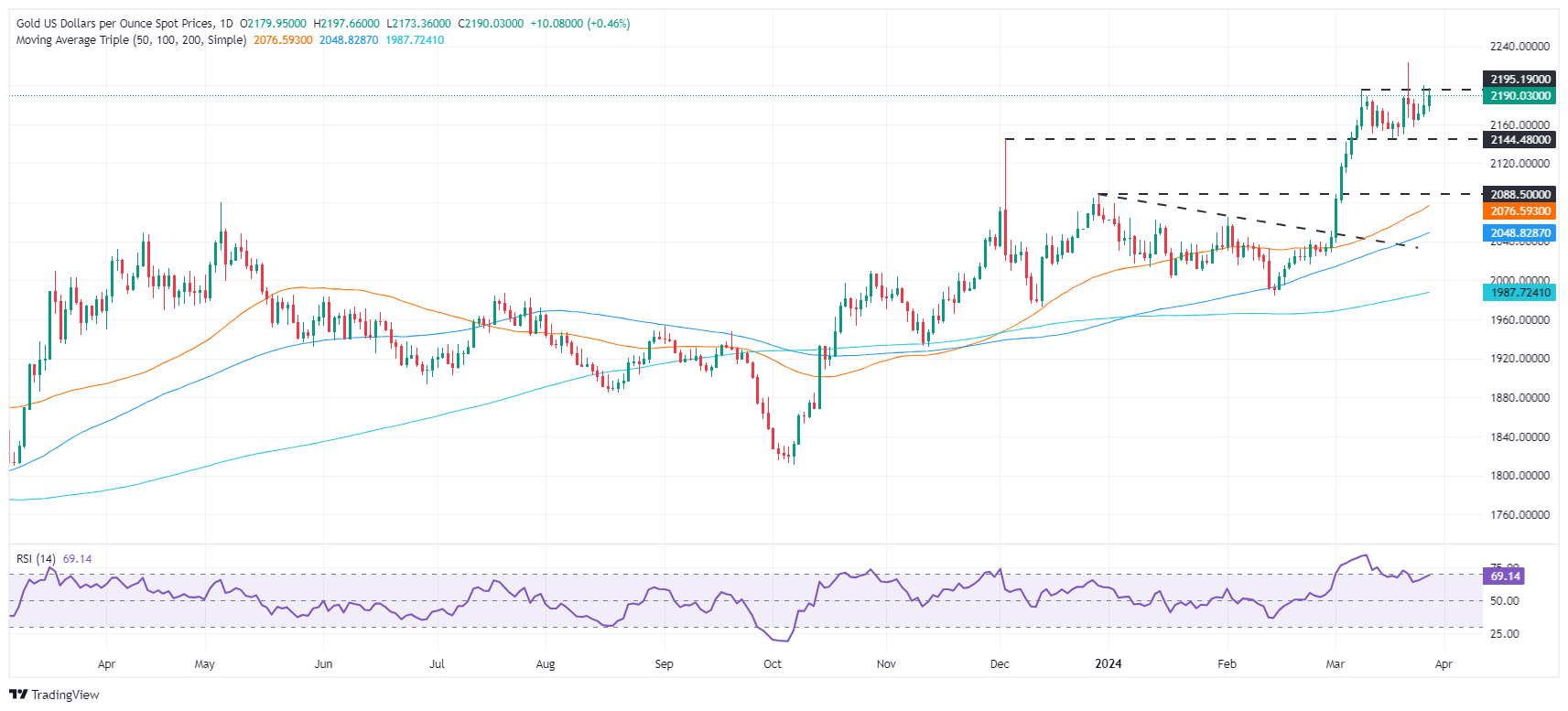Gold on the verge of $2,200 fueled by anticipation of Fed rate cut

- Gold prices ascend, aiming for the $2,200 mark, buoyed by expectations of a Fed rate cut.
- A dip in US Treasury yields to 4.19%, slight decrease in real yields enhance Gold’s appeal as a safe-haven.
- Traders eyed Fed Governor Christopher Waller’s speech and upcoming core PCE data for potential cues on monetary policy direction.
Gold prices climbed steadily during the North American session on Wednesday as buyers targeted the $2,200 figure. A scarce economic calendar in the United States (US) prompted investors to buy the yellow metal on the back of rising speculation of a rate cut in June by the Federal Reserve (Fed). At the time of writing, the XAU/USD trades at $2,192, posting gains of 0.63% or $13.
The fall of US Treasury yields underpins the price of the non-yielding metal. The US 10-year benchmark note rate sits at 4.19%, down four basis points. Consequently, US real yields edged lower from 1.914% on Tuesday to 1.87% as of the time of writing, a headwind for the Greenback.
The US Dollar Index (DXY), which measures the Greenback’s performance against the other six currencies, trades flat at 104.30, a headwind for the non-yielding metal.
The US economic docket is scarce, with just a speech by Fed Governor Christopher Waller at around 22:00 GMT. The highlight of the week will be the release of the Fed’s preferred gauge for inflation, the core Personal Consumption Expenditures (PCE) report, on Friday.
In addition, the current week’s economic calendar will feature University of Michigan Consumer Sentiment, Initial Jobless Claims, and the release of the final reading of the Gross Domestic Product (GDP) on Thursday.
Daily digest market movers: Gold advances as US real yields tumble
- Money market traders predict a 70% chance that the Federal Reserve will slash rates by a quarter of a percentage point in June, setting the federal funds rate (FFR) at 5.00% – 5.25%.
- Federal Reserve officials remain set to cut rates, but there’s division among the Federal Open Market Committee (FOMC) board. Atlanta Fed President Raphael Bostic noted that he expects one rate cut instead of two in 2024. Meanwhile, Fed Governor Lisa Cook echoed Bostic’s comments and added that easing policy too soon increases the risk of inflation becoming entrenched.
- Chicago Fed President Austan Goolsbee remains dovish, expecting three cuts, though he said he needs more evidence of inflation dropping.
- Gold traders await the release of the Federal Reserve’s preferred gauge for inflation, the Core Personal Consumption Expenditure (PCE) Price Index. The Index is estimated to grow 2.8% YoY in February, with monthly figures expected to slow from 0.4% to 0.3% MoM.
Technical analysis: Gold price pushes above $2,190 with buyers targeting all-time high
Gold price resumed its uptrend on Wednesday after diving to a weekly low of $2,163 on Monday, capitalized by buyers, which lifted the yellow metal prices near the $2,200 figure. The Relative Strength Index (RSI), aiming higher, suggests that bullish momentum builds, If traders clear the aforementioned level, a test of the all-time high at $2,223 is on the cards.
On the flip side, if sellers push prices below the December 4 high, which turned support at $2,146, that could exacerbate a sell-off and send XAU/USD prices diving toward $2,100. The next support would be the December 28 high, which is $2,088.
Fed FAQs
Monetary policy in the US is shaped by the Federal Reserve (Fed). The Fed has two mandates: to achieve price stability and foster full employment. Its primary tool to achieve these goals is by adjusting interest rates. When prices are rising too quickly and inflation is above the Fed’s 2% target, it raises interest rates, increasing borrowing costs throughout the economy. This results in a stronger US Dollar (USD) as it makes the US a more attractive place for international investors to park their money. When inflation falls below 2% or the Unemployment Rate is too high, the Fed may lower interest rates to encourage borrowing, which weighs on the Greenback.
The Federal Reserve (Fed) holds eight policy meetings a year, where the Federal Open Market Committee (FOMC) assesses economic conditions and makes monetary policy decisions. The FOMC is attended by twelve Fed officials – the seven members of the Board of Governors, the president of the Federal Reserve Bank of New York, and four of the remaining eleven regional Reserve Bank presidents, who serve one-year terms on a rotating basis.
In extreme situations, the Federal Reserve may resort to a policy named Quantitative Easing (QE). QE is the process by which the Fed substantially increases the flow of credit in a stuck financial system. It is a non-standard policy measure used during crises or when inflation is extremely low. It was the Fed’s weapon of choice during the Great Financial Crisis in 2008. It involves the Fed printing more Dollars and using them to buy high grade bonds from financial institutions. QE usually weakens the US Dollar.
Quantitative tightening (QT) is the reverse process of QE, whereby the Federal Reserve stops buying bonds from financial institutions and does not reinvest the principal from the bonds it holds maturing, to purchase new bonds. It is usually positive for the value of the US Dollar.
